List of dinosaurs
| Genus | Picture | Period | Discovery locations and dates |
|---|---|---|---|
| Acanthopholis |  | Cretaceous (late) | Folkestone, Kent in c. 1865 [3] |
| Altispinax |  | Cretaceous (early) | Battle, East Sussex in 1856 [5] |
| Anoplosaurus |  | Cretaceous (early) | Cambridgeshire, no later than 1878 [6] |
| Aristosuchus |  | Cretaceous (early) | Isle of Wight no later than 1876 [7] |
| Asylosaurus |  | Triassic (late) | Avon Fissure Fill, Bristol in 1834 [8] |
| Barilium |  | Cretaceous (early) | St Leonards-on-Sea, Sussex between 1880 and 1888 [9] |
| Baryonyx |  | Cretaceous (early) | Smokejacks Brickworks, Waverley, Surrey in 1983 [10] Ewhurst Brickworks, Walliswood, Surrey in 1997 [11] Redlands Bricks, Bexhill-on-Sea, East Sussex in 1997 [11] Ashdown Brickworks, Bexhill-on-Sea, East Sussex in 2010 [12] |
| Bothriospondylus |  | Jurassic (middle) | Wiltshire no later than 1875 [13] |
| Brighstoneus |  | Cretaceous (early) | Grange Chine, Isle of Wight in 1978 [14] |
| Calamosaurus |  | Cretaceous (early) | Isle of Wight no later than 1889 [15] |
| Calamospondylus |  | Cretaceous (early) | Isle of Wight in 1865, [16] 1866 [17] and 2014 |
| Callovosaurus |  | Jurassic (middle) | Fletton, Cambridgeshire in 1889 [18] |
| Camelotia |  | Triassic (late) | Westbury-on-Severn, Glastonbury no later than 1985 [19] |
| Camptosaurus |  | Jurassic (late) | Chawley Brick Pits, Cumnor Hurst, Oxfordshire in 1880 [20] |
| Cardiodon | 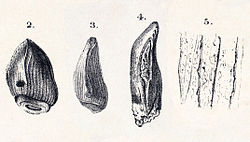 | Jurassic (late) | Bradford-upon-Avon, Wiltshire no later than 1844 [21] Cirencester, Gloucestershire no later than 1890 [22] |
| Ceratosuchops |  | Cretaceous (early) | Chilton Chine, Isle of Wight between 2013 and 2017 [23] |
| Cetiosauriscus |  | Jurassic (mid) | New Peterborough Brick Company, Fletton, Cambridgeshire in 1898 [24] |
| Cetiosaurus | 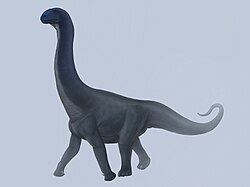 | Jurassic (mid) | 19 sites including: Stonesfield, Oxfordshire in 1825 [25] Staple-Hill, Wootton, Oxfordshire in 1841 [26] Sarsden, Chipping Norton, Oxfordshire in 1888 [27] |
| Chondrosteosaurus |  | Cretaceous (early) | Brighstone or Brook, Isle of Wight no later than 1876 [28] |
| Craterosaurus |  | Cretaceous (early) | Potton, Bedfordshire no later than 1874 [29] |
| Cruxicheiros |  | Jurassic (middle) | Little Compton, Warwickshire in 1960s [30] |
| Cryptosaurus |  | Jurassic (late) | Great Gransden, Cambridgeshire in c. 1869 [31] |
| Cumnoria |  | Jurassic (late) | Chawley Brick Pits, Cumnor Hurst, Oxfordshire in 1879 [32] |
| Dacentrurus |  | Jurassic (late) | Swindon Brick and Tile Company, Swindon, Wiltshire in 1874 [33] |
| Dinodocus |  | Cretaceous (early) | Hythe, Kent in 1840 [34] |
| Dracoraptor |  | Jurassic (early) | Penarth, Wales in 2014 [35] |
| Duriatitan |  | Jurassic (late) | Sandsfoot, Weymouth, Dorset no later than 1874 [36] |
| Duriavenator |  | Jurassic (middle) | Sherborne, Dorset in c. 1882 [37] |
| Echinodon |  | Cretaceous (early) | Durdlestone Bay, Isle of Portland in c. 1861 [38] |
| Eotyrannus |  | Cretaceous (early) | Isle of Wight in 1995 [39] |
| Eucamerotus |  | Cretaceous (early) | Brighstone, Isle of Wight no later than 1872 [40] |
| Eucercosaurus |  | Cretaceous (early) | Trumpington, Cambridgeshire no later than 1879 [41] |
| Eustreptospondylus |  | Jurassic (mid) | Summertown Pit, Wolvercote, Oxfordshire in 1870 [42] |
| Gigantosaurus |  | Jurassic (late) | Cottenham, Cambridgeshire in 1862 [43] Ely, Cambridgeshire in 1862 [43] Stretham, Cambridgeshire in 1862 [43] |
| Haestasaurus |  | Cretaceous (early) | Unknown location near Hastings, East Sussex in 1852 [44] |
| Horshamosaurus |  | Cretaceous (early) | Rudgwick Brickworks Company, Rudgwick, West Sussex in 1985 [45] |
| Hylaeosaurus |  | Cretaceous (early) | Tilgate Forest, Cuckfield, West Sussex in 1822 [46] Stammerham Quarry, Horsham, West Sussex in 1826 [47] Hakesbourne Pit, Rusper, West Sussex in 1842 [48] Bolney, West Sussex in 1851 [49] Ridgeway Hill, Weymouth, Dorset in 1860 [50] Brixton Bay, Isle of Wight in 1874 [51] Ashdown Brickworks, Bexhill-on-Sea, East Sussex in 2010 [12] |
| Hypselospinus |  | Cretaceous (early) | Shornden, East Sussex in 1886 [52] |
| Hypsilophodon |  | Cretaceous (early) | Cowleaze Chine, Isle of Wight in 1849 [53] Isle of Wight in 1979 [54] |
| Iguanodon | 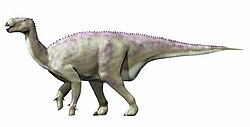 | Cretaceous (early) | Over 60 sites including: First discovery (tooth) at Tilgate Forest, Cuckfield, West Sussex in 1822 [46] |
| Iliosuchus |  | Jurassic (middle) | Stonesfield, Oxfordshire in 1880 [55] |
| Istiorachis |  | Cretaceous (early) | Compton Bay, Isle of Wight in 2013 [56] [57] |
| Iuticosaurus |  | Cretaceous (early) | Brook, Isle of Wight no later than 1887 [58] |
| Juratyrant |  | Jurassic (late) | Dorset in 1984 [59] |
| Mantellisaurus |  | Cretaceous (early) | Rockhill Quarry, Maidstone in 1834 [60] Atherfield, Isle of Wight in 1917 [61] Smokejacks Brickworks, Waverley, Surrey in 1956 [10] Chilton Chine, Isle of Wight in 1976 [62] Grange Cline, Isle of Wight in 1989 [63] |
| Megalosaurus |  | Jurassic (mid) | Over 30 sites including: Tooth at Caswell, Oxfordshire in the 17th century, [64] lower femur at Stonesfield, Oxfordshire in 1676 [65] and over 100 further bones found there from at least 7 individuals by 1911 [66] |
| Metriacanthosaurus | 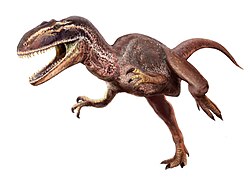 | Jurassic (late) | Jordan's Cliff, Weymouth, Dorset in 1871 [67] |
| Neovenator |  | Cretaceous (early) | Brighstone Bay, Isle of Wight in 1978 [63] |
| Owenodon | 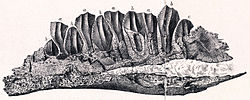 | Cretaceous (early) | Durlston Bay, Dorset in 1860 [68] |
| Pantydraco |  | Jurassic (early) | Pant-y-ffynnon Quarry, Bonvilston, Vale of Glamorgan in 1952 [69] |
| Pelorosaurus |  | Cretaceous (early) | Cuckfield Quarry, West Sussex in 1822 [49] |
| Polacanthus |  | Cretaceous (early) | 12 sites (9 on Isle of Wight, 2 in Sussex, 1 in Essex) including: First discovery (partial skeleton) at Barnes High, Isle of Wight in 1865 [71] Another partial skeleton at Barnes High in 1979 [72] |
| Proceratosaurus | 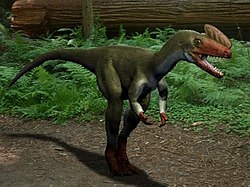 | Jurassic (mid) | Minchinhampton, Gloucestershire in 1910 [73] |
| Riparovenator |  | Cretaceous (early) | Chilton Chine, Isle of Wight between 2013 and 2017 [23] |
| Saltopus |  | Triassic (late) | Partial skeleton at Lossiemouth Quarries, Elgin, Moray in 1867 [74] |
| Sarcosaurus |  | Jurassic (early) | Partial skeleton at Barrow-on-Soar, Leicestershire in 1921 [75] |
| Scelidosaurus |  | Jurassic (early) | Partial skeletons at Charmouth, Lyme Regis, Dorset in 1850s, [78] in 1955 [79] and in 1985 [80] Seatown, Dorset in 1987 [81] |
| Thecodontosaurus |  | Triassic (late) | Durdham Down, Bristol in 1834 [82] Microlestes Quarry, Frome, Somerset in 1871 [83] Holwell, Frome, Somerset in 1889 [84] Ruthin Quarry, Glamorgan in 1957 [85] Tytherington Quarry, Gloucestershire in 1970s [86] |
| Valdosaurus |  | Cretaceous (early) | Tilgate Forest, Cuckfield, West Sussex in 1822 [46] Hakesbourne Pit, Rusper, West Sussex in 1842 [48] Cowleaze Chine, Isle of Wight in 1855 [53] Heathfield, East Sussex in 1975 [87] Isle of Wight in 2001 [39] Horsham, West Sussex in 2009 [88] |
| Vectipelta |  | Cretaceous (early) | Isle of Wight in 1993 [90] [91] |
